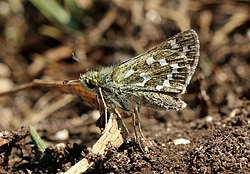Top Qs
Timeline
Chat
Perspective
Grass skippers
Subfamily of butterflies From Wikipedia, the free encyclopedia
Remove ads
Grass skippers or banded skippers[5] are butterflies of the subfamily Hesperiinae, part of the skipper family, Hesperiidae. The subfamily was established by Pierre André Latreille in 1809.[1]
Remove ads
Description and distribution
Summarize
Perspective
With over 2,000 described species, this is the largest skipper butterfly subfamily and occurs worldwide except in New Zealand.[6] About 50 percent of grass skippers live in the Neotropics.[7] 137 species are native to North America. Around 38 species are native to Australia.[8] Genera Ochlodes and Hesperia exist exclusively in the Holarctic.[9]
They are usually orange, rust, or brown in colour and have pointed forewings.[5] Many species have dark markings or black stigmas on their forewings.[5] Most members of this subfamily have an oval antenna club with an apiculus on the tip, although Carterocephalus and Piruna do not.[10] The antennae generally has a sharp bend.
Hesperiinae larvae feed on many different types of grasses and sedges and palms, though some species are limited.[10][11]
Adults typically visit flowers and hold their wings together while feeding.[5] Hesperiinae are unique in that they hold their wings partially open while resting, with the forewings and hindwings held at different angles. This is known as the "jet-plane position".[12] Most male grass skippers perch to await females.[10]
Adults are strong fliers; they move quickly and usually in a linear direction. Some of the species, however, do flutter and these species patrol for females rather than perch.[10]
Remove ads
Conservation
Summarize
Perspective
The following grass skippers are considered at risk.[13]
Remove ads
References
External links
Wikiwand - on
Seamless Wikipedia browsing. On steroids.
Remove ads


